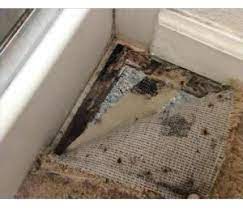A NJ home inspector can look for visible mold although this is a rare occurrence on carpeting. Carpet with visible mold growth is typically not able to be salvaged and should be removed and replaced. Often, if mold is not visible on the carpeting it can be growing under the carpeting where it cannot be easily viewed. Carpet that is suspected of containing mold, should be inspected from both sides. New Jersey home inspectors can try to pick up the corners of the carpeting in order to inspect the underside of the carpeting and the carpet pad.
Any carpeting that has been subjected to water damage from flooding can be subject to mold. Even if mold growth has not occurred yet it can occur within 48 hours of water exposure. Even if the carpet is cleaned or dried there is no guarantee that mold will not grow in the carpeting. If the padding under the carpeting has become wet the upper portion of the carpeting is at risk for mold growth.
Carpeting in basements below grade level is especially at risk if there is high humidity in the basement or where temperature differentials can produce condensation.
The best method for controlling mold growth in carpeting is not to allow for mold growth in the first place. The best way to do so is by ensuring that conditions conducive to mold growth do not exist. Here are some simple ways to prevent carpet mold.
Reduce indoor humidity levels. Controlling humidity to between 45-50% in the home and especially the basement can help prevent mold growth in carpeting. Operating a dehumidifier in the basement of the home is very beneficial especially in the spring and the summer months.
Do not install carpeting in areas that are likely to be exposed to water or high moisture. Carpets in basement and bathrooms can be subjected to high moisture and water causing mold growth to occur.
Make sure to install a high-quality carpet padding. Install a solid rubber carpet padding with an anti-microbial coating which is recommended especially in basements. This will be more expensive than cheaper alternatives, but it can be very helpful in helping to control mold growth especially in areas of high humidity.
Never allow for standing water to collect on a carpeting. Carpeting exposed to water will be ruined quickly. Carpet that is wet should be quickly dried. The entire carpeting must be dried. The top and the bottom surfaces as well as the carpet padding and any floor under the carpeting must be dried quickly if you want a chance to save the carpeting. If the flooding is substantial or if standing water is present for an extended period of time, the carpet will require replacement. When cleaning carpeting use a dry foam cleaner if possible.
In many instances if mold has taken up in a carpeting cleaning will not be possible. If the growth has occurred on more than one area for instance on the bottom of the carpeting and also the carpet pad cleaning will not be possible, and the carpeting should be replaced.
In many cases, if mold has grown on carpet, cleaning will not be possible. If growth has occurred on more than one area of the carpet, or if there is a large area of growth, the carpet will probably need to be replaced.
Small areas of mold growth that have been quickly found can sometimes be cleaned. Detergent and a steam cleaning machine may be enough to clean the carpeting. It is imperative that the carpeting be dried completely after cleaning to prevent the growth of mold from reestablishing itself. More industrial cleaning agents can be used if the detergent is not effective.
Another option would be to remove and replace the affected section of moldy carpeting and pad. This method will only work if the carpet is located in an area where cosmetics do not matter. Finding an exact match may prov challenging and unrealistic.
As with all areas of the home preventing the mold in the first place is the first line of defense. Lowering high moisture conditions and preventing the risk of flooding or water entry.

